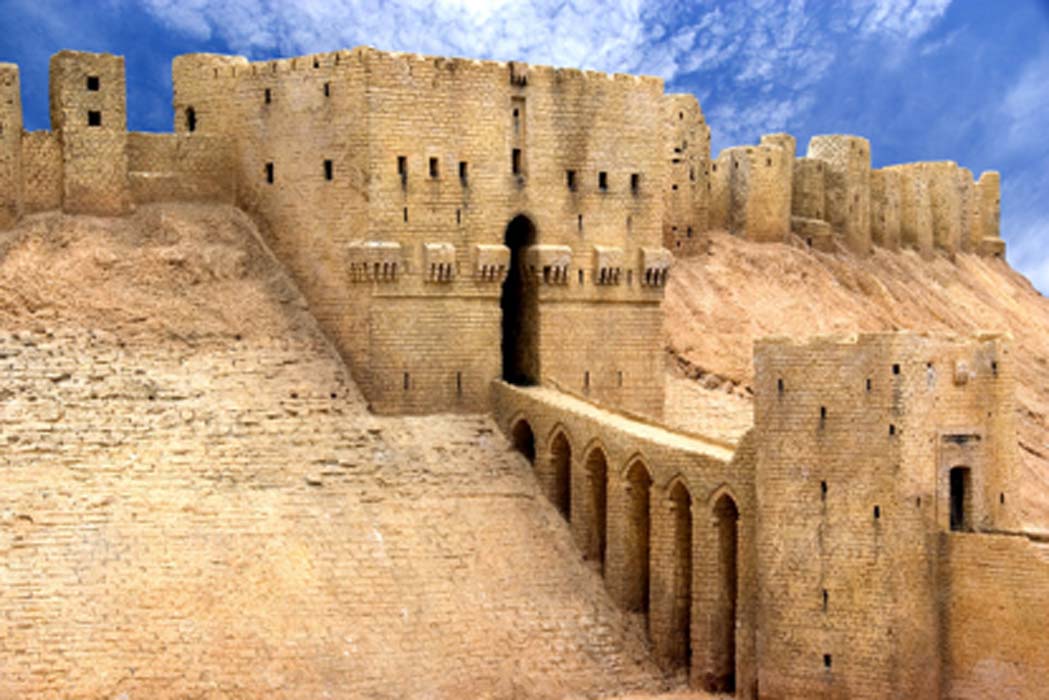Ancient City and Citadel of War-Torn Aleppo Are Syria’s Golden Age Legacy
A quick look up of Aleppo on any search-engine will bring up hundreds of articles about the conflict in Syria and sadly the name has become a byword for the horrors of war. The country though, has a long, remarkable history and is home to many outstanding archaeological and historical monuments. The Citadel of Aleppo, which played an important role in the history of the region for centuries, is one of the most famous.
The Ancient City of Aleppo
The Ancient City of Aleppo lies in the heart of the modern city, a district within the ancient walls. The area has many quarters inhabited by people belonging to different religions and ethnicities, each district socially and economically independent. It is a massive area, covering 350 acres and is home to over 100,000 inhabitants – at least it was before the war.
The area is noteworthy for its many narrow alleys, markets, mansions, travelers’ lodges, as well as religious buildings that are important to both Muslims and Jews.

The Great Mosque of Aleppo (Grzegorz Japol / Adobe Stock)
This city was founded during the Bronze Age and the Ancient City remained largely untouched since the Middle Ages. That was, of course, until the Battle of Aleppo in 2012, which resulted in many sections of the ancient city being destroyed or burnt. In 2014, a series of major historic buildings were further damaged as a result of fighting between the Syrian Arab Army and the rebel forces of Jabhat al-Nusra.
The Citadel of Aleppo
The citadel is located on a hill in the center of Aleppo and is generally accepted to be one of the largest and oldest fortresses in the world.
The fortified hill has been almost continuously occupied since the Bronze Age, occupied by Persians and the Greeks who held the area for several centuries after the conquest of Syria by Alexander the Great. Later it was occupied by the Romans and their successors, the Byzantines. Then it was used by the Arabs, the Seljuk Turks, and the Mamluks.
The present-day fortress was largely constructed by the Ayyubid dynasty, a dynasty of Kurdish origins founded by Saladin who recaptured Jerusalem from the Crusaders. From the 16 th century the Ottomans used the fortress mainly as a barracks.
After WWI, the French occupied the fortress and were the first to conduct archaeological digs at the site. In the 2000s an ambitious program of restoration works was conducted, but during the Syrian Civil War, the citadel was damaged during the Battle of Aleppo. It was reopened in 2017 after numerous repairs.
The citadel is located on a circular mound that measures 1500 by 1,100 feet (500 by 326 m) with the top of the mound at 1000 by 510 feet (300 by 160 m).

The Aleppo Citadel (saxlerb/ Adobe Stock)
The hill was once covered by white slabs of limestone, some of which can still be seen and is surrounded by a deep moat that made it impregnable.
The main entrance is a monumental fortified gateway, which is accessed by an Ottoman covered bridge and has many Islamic architectural motifs. This entrance into the fortress was designed to be a kill-zone where attackers would be vulnerable to the missiles of the defenders. The winding pathway into the inner citadel has a further three large gateways.
The interior of the fortress hosts a large courtyard and among the interesting buildings there are a number of halls that have been restored. These include the Weapons Hall, the Byzantine Hall, and the Ottoman-era Throne Hall, all of which have domed rooves and have been restored to their original magnificence.
- Ancient Syria: Another Cradle of Civilization?
- Huge Bronze Age Citadel, Three Times Larger than Troy, Found in Romania
- Alexander the Great: Was he a Unifier or a Subjugator?

Interior of the citadel of Aleppo (thomashlavac / Adobe Stock)
Two medieval mosques, a minaret, and baths can be found in the fortress, as well as a complete amphitheater. Many of the buildings have not been restored and are now without a roof. A few of the archaeological sites have been opened to the public, such as the Iron Age Hadad Temple. A well dates back to the Hellenistic era and a warren of passage ways lead visitors beneath the buildings. The museum within the citadel which has many artifacts excavated from the site.
Seeing the Citadel of Aleppo
The city is no longer a battleground and is in the full control of the Syrian army and regime. The monument has been fully restored after the damage caused to it during the Battle of Aleppo and is now open to visitors. Visiting Syria, however, may not be possible for many because of continuing international sanctions.
Top image: Entrance to the Aleppo Citadel Source: Shariff Che'Lah / Adobe Stock
By Ed Whelan
References
Burns, R. (2016). Aleppo: a history. Routledge
Available at: https://www.taylorfrancis.com/books/9781315544076
Shadi, W., & Bashar, M. (2015). Syrian archaeological heritage: past and present. Scientific Culture, 1(3), 1-14
Available at: http://monummamluk-syrie.org/Documents-plans/HLB-doc-plans/Syrian%20archeo%20heritage.pdf
Tabbaa, Y. (1993). Circles of Power: palace, citadel, and city in Ayyubid Aleppo. Ars orientalis, 23, 181-200
Available at: https://www.jstor.org/stable/4629448

















